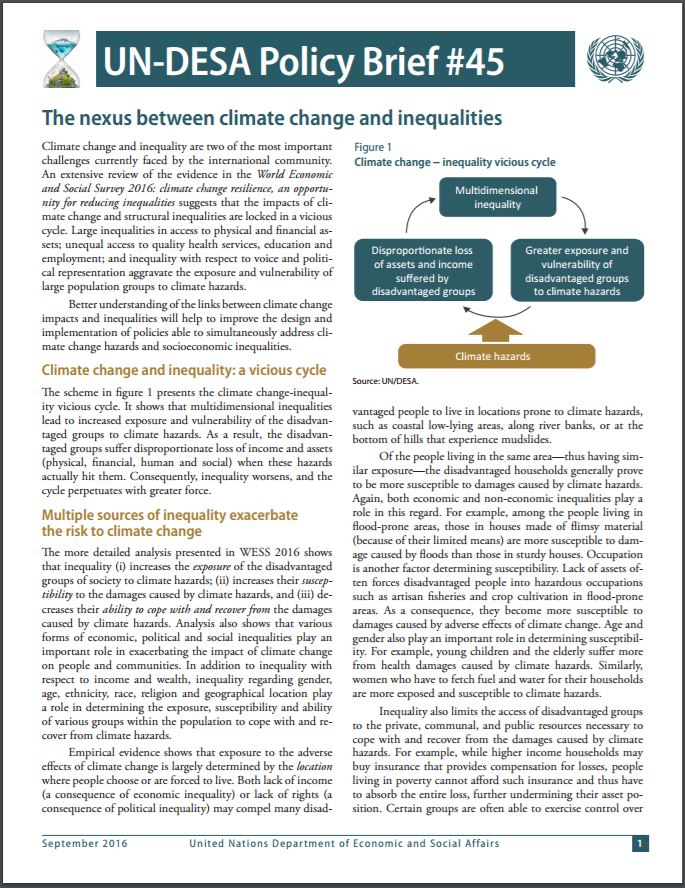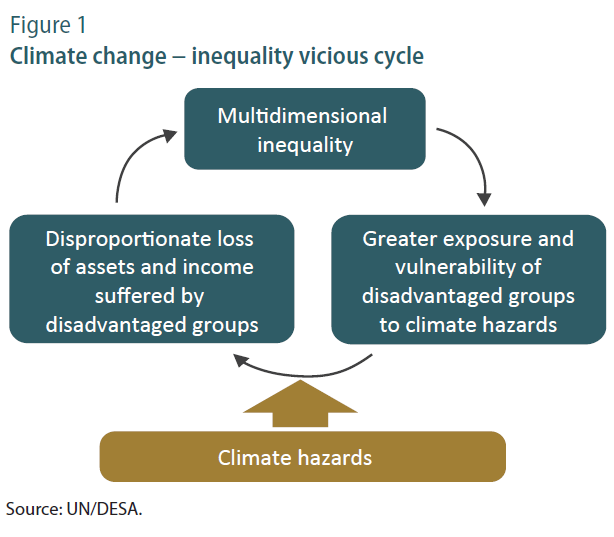
UN/DESA Policy Brief #45: The nexus between climate change and inequalities
Climate change and inequality are two of the most important challenges currently faced by the international community. An extensive review of the evidence in the World Economic and Social Survey 2016: climate change resilience, an opportunity for reducing inequalities suggests that the impacts of climate change and structural inequalities are locked in a vicious cycle. Large inequalities in access to physical and financial assets; unequal access to quality health services, education and employment; and inequality with respect to voice and political representation aggravate the exposure and vulnerability of large population groups to climate hazards.
Better understanding of the links between climate change impacts and inequalities will help to improve the design and implementation of policies able to simultaneously address climate change hazards and socioeconomic inequalities.
Climate change and inequality: a vicious cycle
The scheme in figure 1 presents the climate change-inequality vicious cycle. It shows that multidimensional inequalities lead to increased exposure and vulnerability of the disadvantaged groups to climate hazards. As a result, the disadvantaged groups suffer disproportionate loss of income and assets (physical, financial, human and social) when these hazards actually hit them. Consequently, inequality worsens, and the cycle perpetuates with greater force.
Multiple sources of inequality exacerbate the risk to climate change
The more detailed analysis presented in WESS 2016 shows that inequality (i) increases the exposure of the disadvantaged groups of society to climate hazards; (ii) increases their susceptibility to the damages caused by climate hazards, and (iii) decreases their ability to cope with and recover from the damages caused by climate hazards. Analysis also shows that various forms of economic, political and social inequalities play an important role in exacerbating the impact of climate change on people and communities. In addition to inequality with respect to income and wealth, inequality regarding gender, age, ethnicity, race, religion and geographical location play a role in determining the exposure, susceptibility and ability of various groups within the population to cope with and recover from climate hazards.
Empirical evidence shows that exposure to the adverse effects of climate change is largely determined by the location where people choose or are forced to live. Both lack of income (a consequence of economic inequality) or lack of rights (a consequence of political inequality) may compel many disadvantaged people to live in locations prone to climate hazards, such as coastal low-lying areas, along river banks, or at the bottom of hills that experience mudslides.
Of the people living in the same area—thus having similar exposure—the disadvantaged households generally prove to be more susceptible to damages caused by climate hazards. Again, both economic and non-economic inequalities play a role in this regard. For example, among the people living in flood-prone areas, those in houses made of flimsy material (because of their limited means) are more susceptible to damage caused by floods than those in sturdy houses. Occupation is another factor determining susceptibility. Lack of assets often forces disadvantaged people into hazardous occupations such as artisan fisheries and crop cultivation in flood-prone areas. As a consequence, they become more susceptible to damages caused by adverse effects of climate change. Age and gender also play an important role in determining susceptibility. For example, young children and the elderly suffer more from health damages caused by climate hazards. Similarly, women who have to fetch fuel and water for their households are more exposed and susceptible to climate hazards.
Inequality also limits the access of disadvantaged groups to the private, communal, and public resources necessary to cope with and recover from the damages caused by climate hazards. For example, while higher income households may buy insurance that provides compensation for losses, people living in poverty cannot afford such insurance and thus have to absorb the entire loss, further undermining their asset position. Certain groups are often able to exercise control over common property, based on their social position vis-à-vis other marginalized groups. The existence of entrenched inequalities in the access to voice, power and political representation often leads to public policies that perpetuate large inequalities in access to public resources such as health, education and infrastructure.
Policy implications of the climate change-inequality vicious cycle
The reality of the climate change-inequality vicious cycle has significant policy implications. The international community is committed to mitigating both climate change and inequality. The Sustainable Development Goals (SDGs) provide a framework for the implementation of policies to address the underlying causes of poverty, vulnerability and the risk to climate change simultaneously. SDG 10 calls for the reduction of inequality and SDG 13 calls for actions towards climate change mitigation and strengthening adaptive capacity and resilience to climate hazards. Interlinkages between climate change and inequalities are well reflected in most of the SDGs in recognition of the fact that it will be much harder for countries to make substantive development progress in key areas (such as poverty eradication, food security, healthy lives, among many others) unless people and communities are resilient to the negative impacts of climate hazards.
Achieving these goals is not easy, however. While the challenges posed by climate change gained prominence in more recent years, the challenge of reducing the many dimensions of inequality is long-standing. The persistence, and often widening, of multiple inequalities testifies to the difficulty involved in dealing with this problem.
Inequalities of different types are interrelated. Structural inequalities—such as inequalities with respect to assets, income, voice and political participation—are the underlying source of many other forms of inequality.
The criterion that may guide policymakers through this maze of interrelationships is feasibility, both political and economic. However, what is important to realize is that the space of feasible actions towards reduction of inequality has expanded, owing to the urgency of climate action—perhaps a silver lining in the otherwise dark cloud of climate change! Many adaptation and mitigation measures have become unavoidable. Policy actions, however, must be consistent to make sure efforts to build climate change resilience properly address the underlying cause of inequality. Otherwise, mitigation and adaptation measures may have unintended consequences on inequality. For example, in expanding insurance for people to better cope with and recover from climate hazards, care must be taken to include the disadvantaged groups. This will help them to build assets and raise income. Similarly, in designing a programme to promote salinity resistant crops (an adaptation effort), efforts must be made to cover small and low-income farmers, who so far might have been deprived of necessary agriculture extension services. This may help them raise output and thus increase their income and assets. Similarly, in expanding health services to help local populations better withstand the health consequences of climate hazards, efforts must be made to ensure that people usually excluded will also have access to quality public health services. This will help them to build human capital. In extreme cases, when population groups need to be relocated, efforts must be made to ensure land distribution that is more egalitarian in the new location than it was in the old.
There are numerous examples of ways in which adaptation and mitigation measures create opportunities to reduce inequality. Addressing the root causes of inequalities enables adaptation and the building of resilience to climate hazards, but it requires a continuum of well-designed and integrated policies, including (i) immediate assistance in the wake of climate hazards and disaster risk reduction; (ii) support to facilitate adaptation to a changing climate, entailing, for example, introduction of new crop varieties and water management techniques; (iii) policies centred on ecosystem management and on income diversification; and (iv) sound development policies focused on reducing inequalities to achieve poverty eradication and social inclusion. These specific measures will be most effective in reducing climate change vulnerability when they are part of longer-term transformative strategies which embrace coherent policies across the economic, social and environmental dimensions of sustainable development.
Awareness of the interrelations between climate change resilience and the structural determinants of inequality will help to identify opportunities to break the vicious cycle between climate change and inequality and turn it into a path of inclusive and climate resilient development.

Follow Us